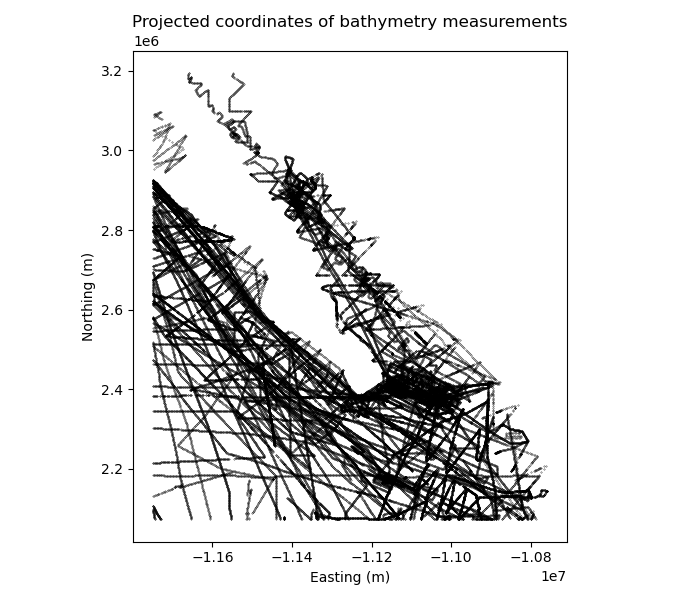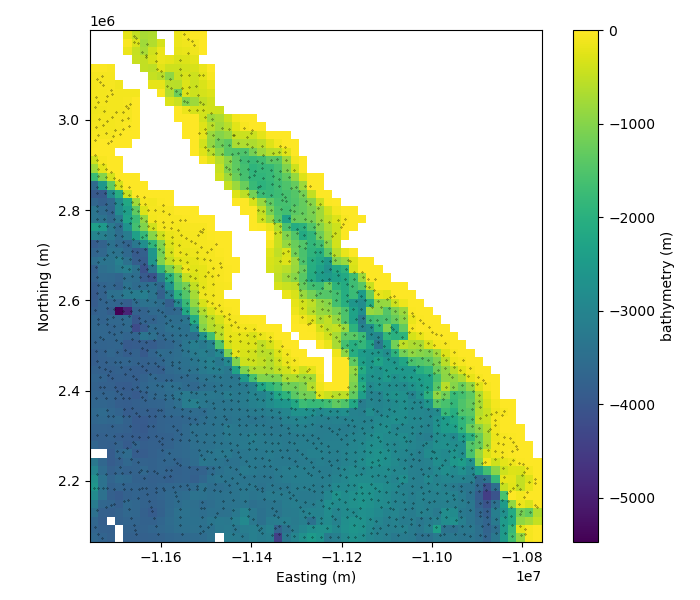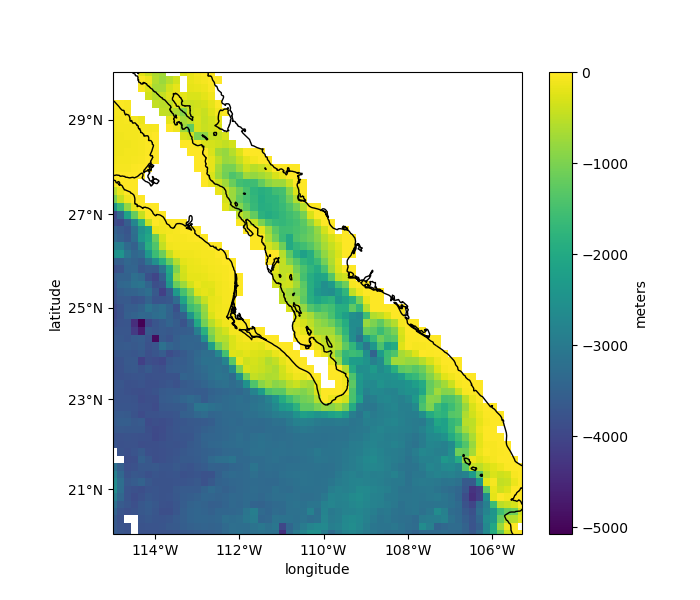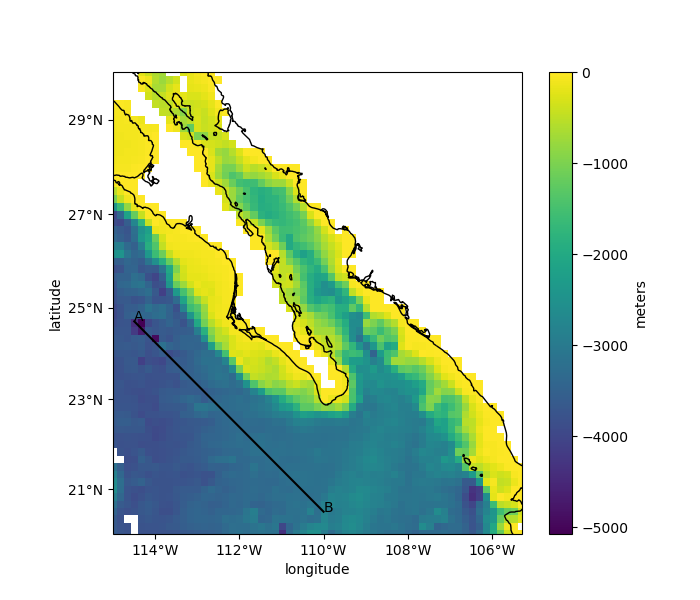Note
Go to the end to download the full example code
Geographic Coordinates#
Most gridders and processing methods in Verde operate under the assumption that the data coordinates are Cartesian. To process data in geographic (longitude and latitude) coordinates, we must first project them. There are different ways of doing this in Python but most of them rely on the PROJ library. We’ll use pyproj to access PROJ directly and handle the projection operations.
import cartopy.crs as ccrs
import matplotlib.pyplot as plt
import numpy as np
import pyproj
import verde as vd
With pyproj, we can create functions that will project our coordinates to and from different coordinate systems. For our Baja California bathymetry data, we’ll use a Mercator projection.
data = vd.datasets.fetch_baja_bathymetry()
# We're choosing the latitude of true scale as the mean latitude of our dataset
projection = pyproj.Proj(proj="merc", lat_ts=data.latitude.mean())
The Proj object is a callable (meaning that it behaves like a function) that will take longitude and latitude and return easting and northing coordinates.
# pyproj doesn't play well with Pandas so we need to convert to numpy arrays
proj_coords = projection(data.longitude.values, data.latitude.values)
print(proj_coords)
(array([-11749316.65303046, -11748999.90777981, -11748682.14077029, ...,
-11749178.7155826 , -11749531.22239381, -11749882.70744613],
shape=(82970,)), array([2905766.05183735, 2905457.83817751, 2905148.48639437, ...,
2579612.89349502, 2580017.48641078, 2580422.09116873],
shape=(82970,)))
We can plot our projected coordinates using matplotlib.
plt.figure(figsize=(7, 6))
plt.title("Projected coordinates of bathymetry measurements")
# Plot the bathymetry data locations as black dots
plt.plot(proj_coords[0], proj_coords[1], ".k", markersize=0.5)
plt.xlabel("Easting (m)")
plt.ylabel("Northing (m)")
plt.gca().set_aspect("equal")
plt.tight_layout()
plt.show()

Cartesian grids#
Now we can use verde.BlockReduce and verde.Spline on our
projected coordinates. We’ll specify the desired grid spacing as degrees and
convert it to Cartesian using the 1 degree approx. 111 km rule-of-thumb.
spacing = 10 / 60
reducer = vd.BlockReduce(np.median, spacing=spacing * 111e3)
filter_coords, filter_bathy = reducer.filter(proj_coords, data.bathymetry_m)
spline = vd.Spline().fit(filter_coords, filter_bathy)
/usr/share/miniconda/envs/test/lib/python3.12/site-packages/verde/blockreduce.py:179: FutureWarning: The provided callable <function median at 0x7f4beb682160> is currently using DataFrameGroupBy.median. In a future version of pandas, the provided callable will be used directly. To keep current behavior pass the string "median" instead.
blocked = pd.DataFrame(columns).groupby("block").aggregate(reduction)
/usr/share/miniconda/envs/test/lib/python3.12/site-packages/verde/blockreduce.py:236: FutureWarning: The provided callable <function median at 0x7f4beb682160> is currently using DataFrameGroupBy.median. In a future version of pandas, the provided callable will be used directly. To keep current behavior pass the string "median" instead.
grouped = table.groupby("block").aggregate(self.reduction)
If we now call verde.Spline.grid we’ll get back a grid evenly spaced
in projected Cartesian coordinates.
grid = spline.grid(spacing=spacing * 111e3, data_names="bathymetry")
print("Cartesian grid:")
print(grid)
Cartesian grid:
<xarray.Dataset> Size: 27kB
Dimensions: (northing: 61, easting: 54)
Coordinates:
* northing (northing) float64 488B 2.074e+06 2.093e+06 ... 3.19e+06
* easting (easting) float64 432B -1.175e+07 -1.173e+07 ... -1.077e+07
Data variables:
bathymetry (northing, easting) float64 26kB -3.635e+03 ... 8.87e+03
Attributes:
metadata: Generated by Spline(mindist=0)
We’ll mask our grid using verde.distance_mask to get rid of all the
spurious solutions far away from the data points.
grid = vd.distance_mask(proj_coords, maxdist=30e3, grid=grid)
plt.figure(figsize=(7, 6))
plt.title("Gridded bathymetry in Cartesian coordinates")
pc = grid.bathymetry.plot.pcolormesh(cmap="viridis", vmax=0, add_colorbar=False)
plt.colorbar(pc).set_label("bathymetry (m)")
plt.plot(filter_coords[0], filter_coords[1], ".k", markersize=0.5)
plt.xlabel("Easting (m)")
plt.ylabel("Northing (m)")
plt.gca().set_aspect("equal")
plt.tight_layout()
plt.show()

Geographic grids#
The Cartesian grid that we generated won’t be evenly spaced if we convert the
coordinates back to geographic latitude and longitude. Verde gridders allow
you to generate an evenly spaced grid in geographic coordinates through the
projection argument of the grid method.
By providing a projection function (like our pyproj projection object),
Verde will generate coordinates for a regular grid and then pass them through
the projection function before predicting data values. This way, you can
generate a grid in a coordinate system other than the one you used to fit the
spline.
# Get the geographic bounding region of the data
region = vd.get_region((data.longitude, data.latitude))
print("Data region in degrees:", region)
# Specify the region and spacing in degrees and a projection function
grid_geo = spline.grid(
region=region,
spacing=spacing,
projection=projection,
dims=["latitude", "longitude"],
data_names="bathymetry",
)
print("Geographic grid:")
print(grid_geo)
Data region in degrees: (np.float64(245.0), np.float64(254.705), np.float64(20.0), np.float64(29.99131))
Geographic grid:
<xarray.Dataset> Size: 30kB
Dimensions: (latitude: 61, longitude: 59)
Coordinates:
* latitude (latitude) float64 488B 20.0 20.17 20.33 ... 29.66 29.82 29.99
* longitude (longitude) float64 472B 245.0 245.2 245.3 ... 254.4 254.5 254.7
Data variables:
bathymetry (latitude, longitude) float64 29kB -3.621e+03 ... 9.001e+03
Attributes:
metadata: Generated by Spline(mindist=0)
Notice that grid has longitude and latitude coordinates and slightly different number of points than the Cartesian grid.
The verde.distance_mask function also supports the projection
argument and will project the coordinates before calculating distances.
grid_geo = vd.distance_mask(
(data.longitude, data.latitude), maxdist=30e3, grid=grid_geo, projection=projection
)
Now we can use the Cartopy library to plot our geographic grid.
plt.figure(figsize=(7, 6))
ax = plt.axes(projection=ccrs.Mercator())
ax.set_title("Geographic grid of bathymetry")
pc = grid_geo.bathymetry.plot.pcolormesh(
ax=ax, transform=ccrs.PlateCarree(), vmax=0, zorder=-1, add_colorbar=False
)
plt.colorbar(pc).set_label("meters")
vd.datasets.setup_baja_bathymetry_map(ax, land=None)
plt.show()

/home/runner/work/verde/verde/doc/tutorials_src/projections.py:143: UserWarning: All kwargs are being ignored. They are accepted to guarantee backward compatibility.
vd.datasets.setup_baja_bathymetry_map(ax, land=None)
Profiles#
For profiles, things are a bit different. The projection is applied to the input points before coordinates are generated. So the profile will be evenly spaced in projected coordinates, not geographic coordinates. This is to avoid issues with calculating distances on a sphere.
The coordinates returned by the profile method will be in geographic
coordinates, so projections given to profile must take an inverse
argument so we can undo the projection.
The main utility of using a projection with profile is being able to pass
in points in geographic coordinates and get coordinates back in that same
system (making it easier to plot on a map).
To generate a profile cutting across our bathymetry data, we can use longitude and latitude points taken from the map above).
latitude longitude distance bathymetry
0 24.700000 -114.500000 0.000000 -4115.540285
1 24.679226 -114.477387 3276.548360 -4397.069052
2 24.658449 -114.454774 6553.096720 -4766.953632
3 24.637668 -114.432161 9829.645080 -5198.947538
4 24.616884 -114.409548 13106.193440 -5639.303390
.. ... ... ... ...
195 20.585669 -110.090452 638926.930221 -3016.467547
196 20.564257 -110.067839 642203.478581 -2969.351779
197 20.542841 -110.045226 645480.026941 -2914.069305
198 20.521422 -110.022613 648756.575301 -2859.557817
199 20.500000 -110.000000 652033.123661 -2818.101949
[200 rows x 4 columns]
Plot the profile location on our geographic grid from above.
plt.figure(figsize=(7, 6))
ax = plt.axes(projection=ccrs.Mercator())
ax.set_title("Profile location")
pc = grid_geo.bathymetry.plot.pcolormesh(
ax=ax, transform=ccrs.PlateCarree(), vmax=0, zorder=-1, add_colorbar=False
)
plt.colorbar(pc).set_label("meters")
ax.plot(profile.longitude, profile.latitude, "-k", transform=ccrs.PlateCarree())
ax.text(start[0], start[1], "A", transform=ccrs.PlateCarree())
ax.text(end[0], end[1], "B", transform=ccrs.PlateCarree())
vd.datasets.setup_baja_bathymetry_map(ax, land=None)
plt.show()

/home/runner/work/verde/verde/doc/tutorials_src/projections.py:191: UserWarning: All kwargs are being ignored. They are accepted to guarantee backward compatibility.
vd.datasets.setup_baja_bathymetry_map(ax, land=None)
And finally plot the profile.
plt.figure(figsize=(8, 3))
ax = plt.axes()
ax.set_title("Profile of bathymetry (A-B)")
ax.plot(profile.distance, profile.bathymetry, "-k")
ax.set_xlabel("Distance (m)")
ax.set_ylabel("Bathymetry (m)")
ax.set_xlim(profile.distance.min(), profile.distance.max())
ax.grid()
plt.tight_layout()
plt.show()

Total running time of the script: (0 minutes 1.223 seconds)